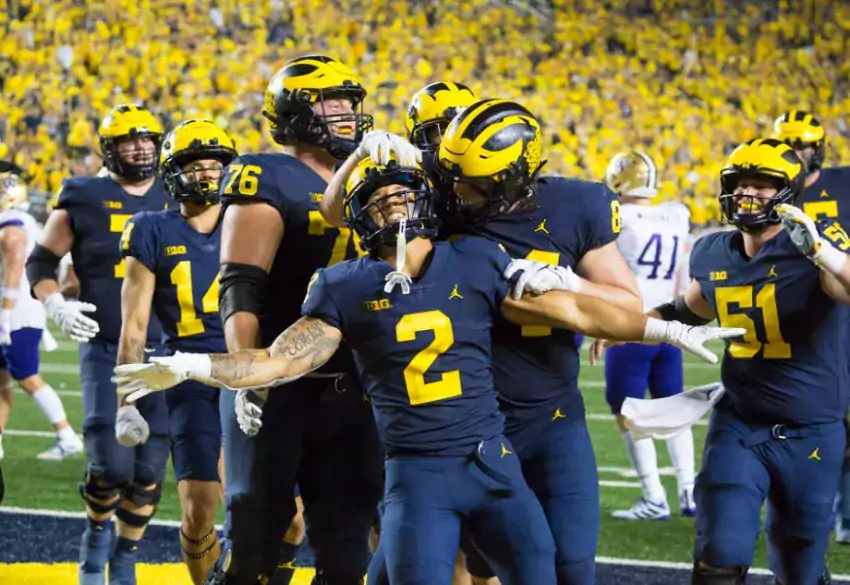
Neck Sharpies: I Can Do This All Day

Throwing a quick one up to highlight something that got too long in the UFR. You already know the gameplan against Washington: Run. You probably figured out why they stuck to the gameplan too: Washington was hyperfocused on stopping everything but the run.
Specifically, Michigan was finding ways to get their big burly linemen involved in run blocking the cadre of Husky OLB/DEs they were rotating through, and the main way of doing that was to bring multiple dudes across the formation.
Their base plays this game were Split Zone and various forms of Counter. Here’s the 2nd play of the game (after the false start):
If you caught everything going on here in the first viewing, please apply to Jim Harbaugh immediately because you were born a coaching savant. For the rest of you, here’s what I saw:
Basically it’s Counter Trey except they shifted everything a gap inwards. Here’s how:
- Kickouts of the overhang CB and the SAM with the F-back (All) and pulling center (Vastardis).
- A zone block of the frontside Tackle with the Y (Schoonmaker)—block him down if he wants to go that way or kick him out if he tries to go to Schoonmaker’s left shoulder.
- The biggest lead blocker the can find (RT Andrew Stueber) pulling around to remove the free MLB from whichever gap the T didn’t choose.
- Downblocks on the other two DL and WLB with the guards (Keegan and Zinter) and frontside tackle (Hayes).
- An RPO snag concept going on with the backside to keep the Jack from crashing on a long-developing run play.
I wanted to highlight the player matchups because those are important.
[After THE JUMP: Across the formation]
If you remember your Counter Trey rules you should remember all the ways a defense tends to blow it up. A refresher:
The zone block on the frontside is an interesting wrinkle. You look at that as THE key block. It’s not even on the Counter Trey rules above, which just say, basically, don’t lose to that DT. That DT in this case is two-gapping Tuli Letuligasenoa, and the scouting on him (pre-Montana, when Michigan was building their game plan) was Tuli’s going to be a problem for more than stadium announcers and podcasters. You really want to send your iffiest blocking TE against that guy?
Well yeah, that’s the whole point. The trick here is by making it a zone block of a player who *ISN’T* lined up over the guy blocking him, you’ve actually put Schoonmaker in a decent position. Chances are that guy is going in the gap he lined up in, in which case it’s a simple downblock, and Schoonmaker should be able to lock him inside far enough to create a right side for the gap. If that tackle decides to try to get to the other side of Schoonmaker, that’s a fight that the tight end can let him win. That’s what happens here.
Watch again and pay attention to Schoonmaker:
TE#86, the tight end on the line of scrimmage at the bottom
Congratulations, Tuli, you two-gapped yourself.
The offense also gamed up matchups they wanted for the other two blocks that have to go right for the gap to be created. The kickout of the edge defender here went to Andrew Vastardis, the center. Normally with counter that’s a backside guard but if Michigan is going to execute that zone block on the frontside, they need the kickout to happen as far out there as possible. Rather than wait for a guard, you can get a gap of a head start by sending Vastardis, who’s faster than Zinter even if he doesn’t pack quite as much wallop (either will do in this case). Watch the OLB/DE standing up at the bottom of the line, and which way his shoulders go when Vastardis impacts him. That guy has no recourse but to spin off the block, and by then the RB is gone.
The downblocks of the NT and WLB are also very important if you’re running this a gap further inside than usual. For that they’re having their best lineman (this week) Ryan Hayes and big Trevor Keegan block down.
A thunk from Hayes in addition to Keegan was enough to put that NG, Sam “Taki” Taimani, the other Problem, where he will not be one.
Taki isn’t the helmet you see between them, he’s that third knee and flash of jersey, because Keegan and Hayes wiped this guy right into the next block. Also the WLB is still watching the backside instead of hauling after the pulling RT because they’re playing extreme “don’t get edged” defense. The ease with which Taki was displaced by a short double was an eye-opening moment, but also part of the plan all along.
That’s the 2nd play of the game. Here’s the penultimate:
What does it look like?
Michigan clearly put together a game plan expecting to mess with Washington’s front. This play looks for all the world like another Counter run to the right, after a day of tight ends and receivers and guards sliding from the backside to blast edge defenders and running between that and blocked down interior linemen. This play punished the hell out of a defense reacting to that. As soon as Keegan stands up the LBs are thinking he might pull. Schoonmaker and Henning going out there sell the action further. I think Michigan was also expecting the CB to rotate high so the FS could come down on the Henning end-around (Hend-around?) (Workshopping this.)
But the CB didn’t. He hung out on the edge. And both safeties were dropping deep. At this point—in case the scouting on Michigan wasn’t enough—the Wolverines had run on 29/34 standard downs, and every single first down. AND YET:
The running back has the ball, in the 4th quarter, of a game Michigan is salting away by running up the gut all night long, and still Washington had their safeties in a two-deep shell, still moving backwards, and extra defenders on the edge or where they can get to it in a hurry. We DARE you to pass! No.
From the first play to the end of the game, this was the relationship between Michigan’s offense and Washington’s defense. Michigan kept moving around which gaps they wanted to attack inside with plays that sent one to three players across the formation for kicks, often in opposite directions of each other to keep the linebackers frozen in place.
But where were the RPOs?
Washington was also hyper-vigilant about not getting edged. When we got to the end of the game I was wondering what happened to all the #SpeedinSpace RPOs, but as I charted I found a few of them. They were just very covered up. Let’s go back to the 2nd play of the game:
There were a bunch of positive reads for McNamara in this game despite Michigan being as QB givey as ever, simply because Washington kept making the handoff the correct decision.
The story of this game is Washington dared Michigan to beat them up the gut until their RBs were worn to nubs, their OL were gassed from trying to move Tuli and Taki out of the way, and various former receivers were chirping about “Never go to Michigan.” Then Michigan dared, succeeded, and the Huskies just dared them again.
Jimmy Lake: I can do this all day.
And no safeties came to help, so we ran some more.
safeties: you know you can join in any time.
The end.
September 14th, 2021 at 6:08 PM ^
This site's content amazes me. So high-level, and anyone complaining about the gameplan after reading this needs to STFU. We did what many on this board -- including me -- have been wanting. We took what they gave us, and kept on doing that. We also stuck with what was working. These are both huge steps forward.
Excellent write-up, Seth!!
September 14th, 2021 at 6:22 PM ^
I had both feelings. Nuance and stuff. But I posted right away that I thought Washington’s game plan reminded me of Durkin vs Ohio state. At some point, you have to try to fire those safeties down. It was odd
September 14th, 2021 at 6:35 PM ^
Seems to be tactically opposite how I would approach harbaugh teams but alas. In general, would have thought bringing extra help into box and leaving their very good corners with less help against our unproven receivers would have been the way to go as opposed to daring harbaugh to keep using the 2 best parts of our offense…what do I know though?
September 14th, 2021 at 7:40 PM ^
This is a pick your poison proposition though. First, I think they thought they could control the running game with their front seven. Second, they had to be concerned about the gash plays Michigan was getting on Western-and, remember, Cade was money against Western. Corum and Haskins are not going down easily and both, Corum for sure, will take is to the house in a flash if you further stack the box and they keep hitting those seams the OL is carving out.
September 14th, 2021 at 8:46 PM ^
I think they went in against a Sicilian when death was on the line.
September 14th, 2021 at 7:27 PM ^
Corum is a different back this year. Hart has him playing at an All-American level. With that speed, power and low center of gravity...he is turning into one outstanding running back.
September 14th, 2021 at 9:31 PM ^
Hart on steroids. When all said and done he will be considered one of our best in the modern era. Best Harbaugh, Hoke, RR had. I think he passes Hart, too.
September 14th, 2021 at 8:25 PM ^
UW still out hit us…
September 14th, 2021 at 10:44 PM ^
Is the quip about former Michigan receivers saying/typing "never go to Michigan" something I missed? Or just a comment in jest?
September 15th, 2021 at 3:28 AM ^
Jest. But everything is a balancing act. You win the game first always but NFL ready receiver are what we want, 50 yard of passing isnt going to bring them here. Or maybe mocking my last statement you be the judge.
September 15th, 2021 at 9:50 AM ^
This is a meme from Frost when he was at UCF and Michigan blasted them..After the game he said UCF outhit Mich.
September 15th, 2021 at 5:07 AM ^
As part of a coaching staff that just spent last week trying to defend a ton of stretch from Michigan's last formation shown in this post, I knew when Michigan lined up that way that it would be stretch to the left. I hope Michigan runs a lot of stretch with Corum this year, because he has the quickness and vision to get some huge plays out of that scheme.
If he truly is Mike Hart but fast - and Hart was excellent at stretch - then Corum should be even better.
September 15th, 2021 at 8:09 AM ^
Seth, I have a somewhat different read on the first clipped play. To me, it just looks like power out of different personnel. For one, there is no counter action in the backfield, which is usually necessary to influence the backer flow you want on a counter to get good blocking angles on them.
Instead of a fullback or tight end kicking out and a guard turning up, it looks like the center kicking out and the backside tackle turning up. I think you might be seeing a zone block where there isn't really one.
Are there any other examples with the center and backside tackle pulling? If so, and there is a different front, we might be able to look at the adjustments to see which of us is right. This isn't a challenge, by the way. I've complimented you for years, and find your analysis better than Brian's, by and large. But it might be interesting to look at other examples, ideally out of the same formation, against different fronts.
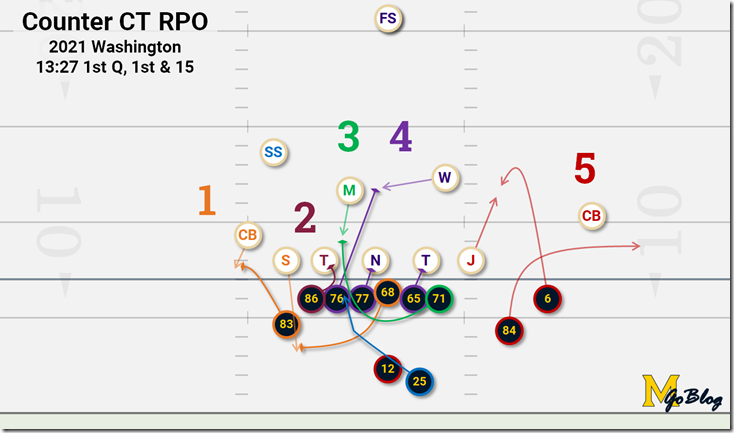
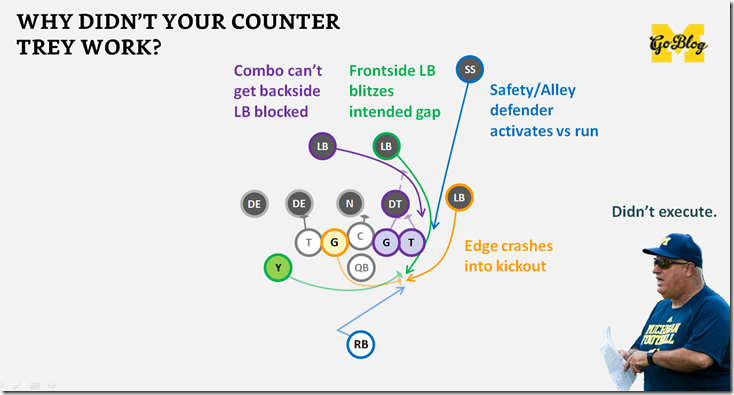
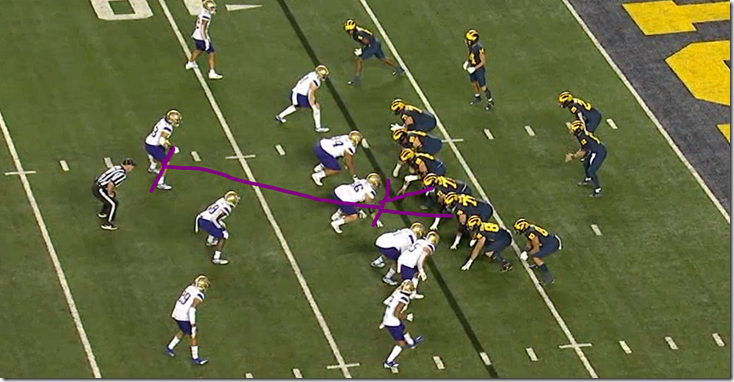
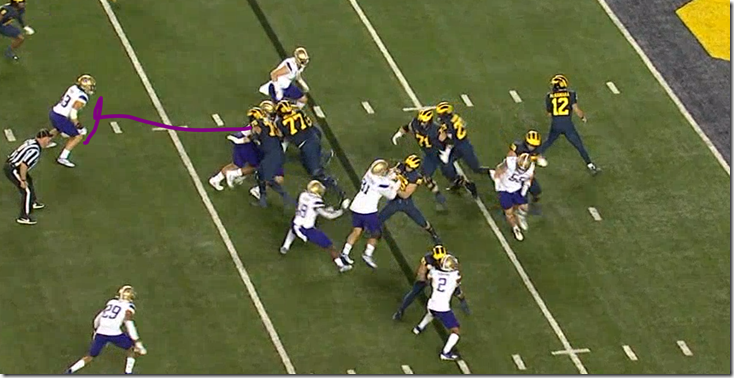

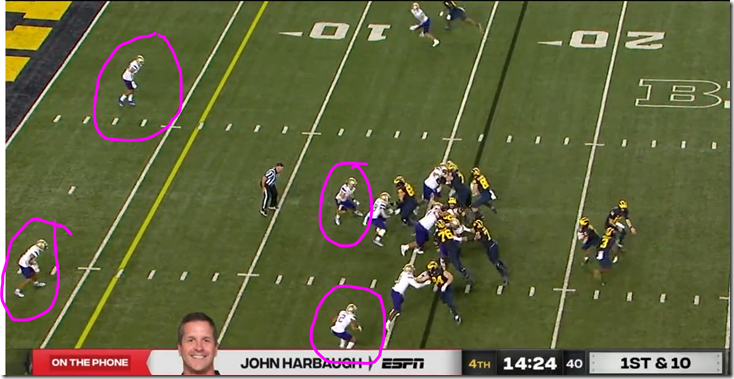
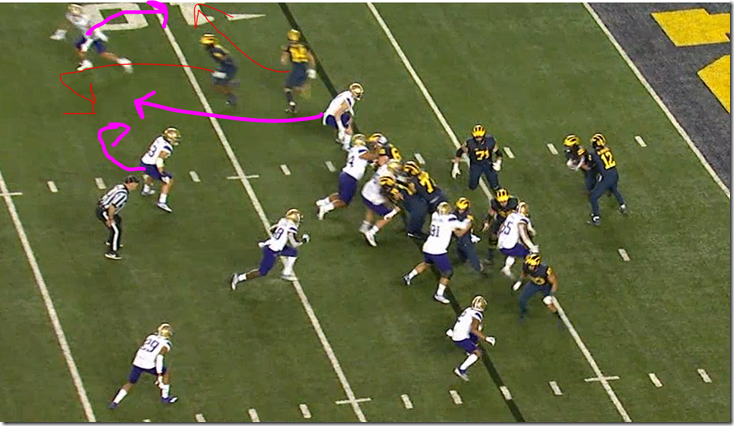
Comments